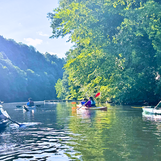Stream Assessments in a Socially Distant Landscape
- pomperaugriver

- Dec 9, 2020
- 3 min read
With several COVID-safety protocols in place (masks, separate cars, hand-sanitizer, etc.), PRWC kicked off a busy field season in May with the deployment of data loggers that record stream temperature every hour through the summer, introduced a new stream crossing assessment program following North Atlantic Aquatic Connectivity Collaborative (NAACC) protocols, and sampled streams every two weeks for bacteria, nitrate and conductivity. The season closed in October with our 15th Annual Macroinvertebrate Survey and retrieval of the data loggers.

Stream Crossing Assessments This year, PRWC staff members were trained in NAACC’s model for stream crossing assessments. Quality crossings are important to the migration and movement of aquatic life up and down rivers. With assistance from the YCC crew, PRWC completed 22 culvert and bridge assessments. Each structure was assessed by characteristics such as shape, height, depth, width, substrate, alignment, streamflow constriction, blockage, and overall physical condition. Analysts at NAACC then assign an aquatic life passage barrier rating based on the data submitted. Ratings range from no barrier to severe barrier and help to highlight which crossings may be prioritized for repair or replacement. The data also helps evaluate a structure’s abilty to handle increasing storm volumes, which is an important element of pre-hazard mitigation and resiliency planning.
Bacteria sampling For the second year, PRWC collected E. coli bacteria samples from 13 sites throughout the watershed with increased sampling frequency between from June to October. The Dr. Marc Taylor Interns and Youth Conservation Corps took up sampling during the summer months and updated maps with lab results. The new interactive map they created is available for public viewing on our website. It provides information on whether the bacteria results met thresholds for water-based recreational activities at the time of the sample. With three stream segments previously identified by CT DEEP as having high bacteria levels, PRWC is collecting more widespread data to better understand the extent of the impairments and potential sources of bacteria and where to focus efforts to reduce the pollutant load.
Macroinvertebrate Survey In October, eleven wonderful volunteers participated in online training sessions before joining PRWC in the field to collect macroinvertebrate samples. Over the course of two Saturdays, a total of six sites were surveyed following DEEP’s protocols for Riffle Bioassessment by Volunteers program. Samples from each site, including those from two new sites - Carmel Hill Brook in Woodbury and Eight Mile Brook in Oxford - have been submitted to CT DEEP to confirm identification of the specimens collected. The presence of certain species of macroinvertebrates - those highly sensitive to pollution and changing environmental conditions - help identify high quality streams. If four or more of these highly sensitive creatures are found at a sample site, the stream is designated as high quality for its ability to support aquatic life. If fewer than that are found, additional assessments will be needed before making a water quality determination. Results for this season are forthcoming.
Stream Temperature Monitoring As part of DEEP’s Volunteer Stream Temperature Monitoring program (VSTeM), PRWC has maintained a network of monitoring sites throughout the watershed since 2012. This year, 10 data loggers were deployed to record water temperature every hour between June and mid-October. The data collected from June 1 to August 30 are the most critical in evaluating the thermal regime of a river - warm, cool/transitional, or cold. Certain species of fish including the eastern brook trout depend on cold water to survive, while other species like bass and perch prefer warm water and others still are able to thrive in a wide range of water temperatures. As eastern brook trout is a species particularly vulnerable to climate change, the identification and protection of cold water streams is a high priority throughout the northeast. Of the sites monitored by PRWC, one has met the criteria to be classified as cold water habitat though the data for this year ranked it as transitional or cool. The interactive map on our website provides summary data from each year a site has been monitored. Over the winter, we’ll be analyzing the data more closely to look for trends and correlations to air temperature and precipitation.










